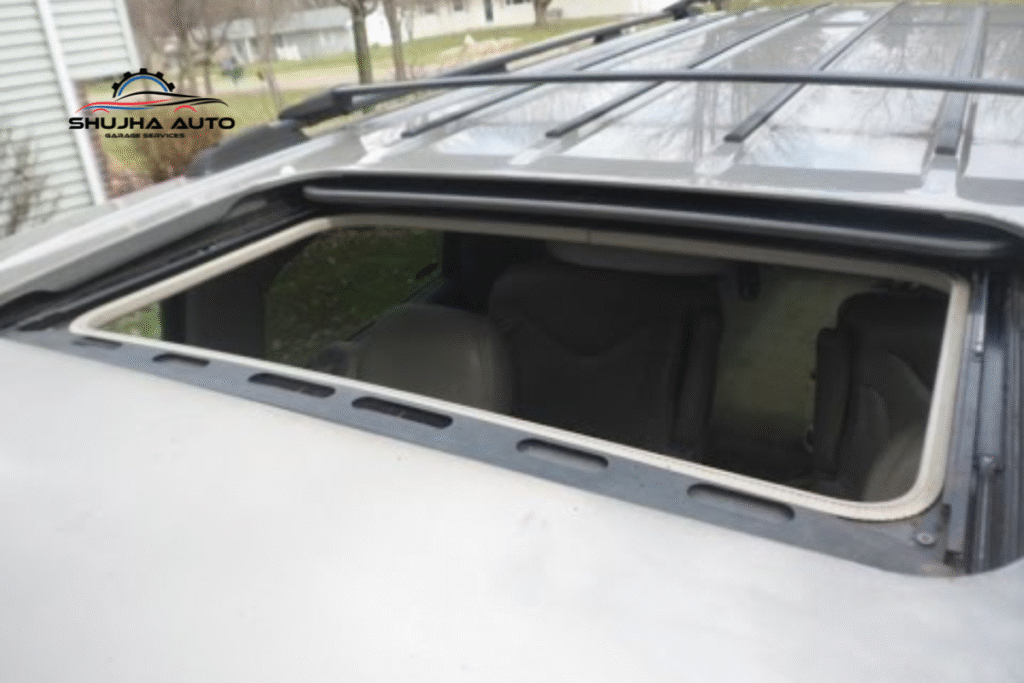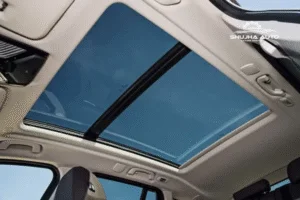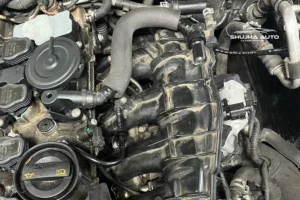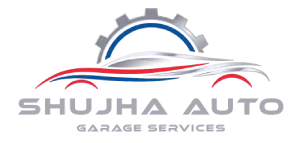Fix your Hummer H3 sunroof leak with ease. Discover 7 essential tools you need to clean drains, seal gaps, and stop water intrusion effectively.
The Hummer H3 is a rugged SUV designed for adventure. But when water starts dripping through its sunroof, that tough exterior can feel fragile. Fixing that leak promptly keeps the interior dry, prevents mold, and saves you from costly repairs in the future.
In this post, we’ll cover 7 essential tools to fix a Hummer H3 sunroof leak:
- Rubbing Alcohol and Clean Rags
- Silicone Sealant or Automotive RTV
- Flexible Drain Cleaning Brush or Snake Tool
- Compressed Air Can or Air Compressor
- Phillips and Flathead Screwdrivers
- Plastic Pry Tools
- UV Leak-Detection Dye and UV Light
Each tool plays a crucial role in diagnosing and repairing leaks, ensuring your H3 stays dry and comfortable. And if it gets tricky? Shujha Auto Garage Services is here to help.
Why Fixing a Sunroof Leak Matters
A leaking sunroof isn’t just an annoyance—it’s a risk:
- Water can damage the headliner, electronics, and interior trim.
- Mold and mildew can form, causing odors and health problems.
- Rust and corrosion can spread, affecting the vehicle’s structure.
- A small leak can become a big problem if ignored.
With the right tools and a good repair, you can keep your Hummer reliable and leak‑free.
Tool #1: Rubbing Alcohol and Clean Rags
- Why it’s essential: Prepping the surface is crucial. Rubbing alcohol and clean rags remove old sealant, grease, and grime so new material bonds well.
- How to use it:
- Spray rubbing alcohol onto a clean rag.
- Rub the sunroof’s edge thoroughly—inside and outside.
- Repeat until no dirt or residue remains.
- Spray rubbing alcohol onto a clean rag.
- Benefits: Clean surfaces help the silicone sealant or automotive RTV stick properly, reducing the chance of a recurring leak.
Tool #2: Silicone Sealant or Automotive RTV
- Why it’s essential: Once clean, you need a strong waterproof seal. Use silicone sealant or automotive RTV to fill gaps or cracks around the sunroof.
- How to use it:
- Apply a thin bead of sealant in needed areas (edges, drains, screws).
- Smooth it gently with a tool or finger.
- Allow to cure for 24 hours.
- Apply a thin bead of sealant in needed areas (edges, drains, screws).
- Tips: Use a silicone sealant or automotive RTV rated for automotive use—they resist UV and temperature changes better than household silicone.
Tool #3: Flexible Drain Cleaning Brush or Snake Tool
- Why it’s essential: Clogged drains are one of the most common causes of leaks. A flexible drain cleaning brush or snake tool clears debris from sunroof drain tubes.
- How to use it:
- Locate drain openings near sunroof corners.
- Gently insert the brush or snake about 12–18 inches.
- Spin and pull to clear blockages.
- Test drainage: pour water and watch it exit under the vehicle.
- Locate drain openings near sunroof corners.
- Tips: Use gentle pressure—don’t poke hard. After cleaning, test for leaks and secure edges with sealant.
Location: Please Visit Our Shujha Auto Garage
Tool #4: Compressed Air Can or Air Compressor
- Why it’s essential: After brush cleaning, water may still be hidden in the tubes. Use a compressed air can or an air compressor to dry them out quickly.
- How to use it:
- Plug a tube with a cloth, leaving the other end open.
- Blow short bursts of air through the tube.
- Listen for sputtering—when it stops, it’s dry.
- Plug a tube with a cloth, leaving the other end open.
- Benefits: Prevents damp spots, mold, and helps seal areas dry before applying sealant.
Tool #5: Phillips and Flathead Screwdrivers
- Why it’s essential: Removing trim, fasteners, and accessing flawed panels requires Phillips and flathead screwdrivers—versatile tools for dismantling and reassembling without damage.
- How to use them:
- Remove screws holding sunroof frame or interior trim.
- Use a flathead to gently pry trim or clips.
- Re-tighten screws after cleaning and sealing.
- Remove screws holding sunroof frame or interior trim.
- Tips: Keep screws organized. Once reinstalled, apply a small bead of silicone sealant or automotive RTV around screw heads.
Tool #6: Plastic Pry Tools
- Why they’re essential:
Trims and clips can be damaged by metal tools. Plastic pry tools prevent scratches and breakage. - How to use them:
Gently insert under trim edges, then lift or pry to release clips without damaging plastic or paint.
Tool #7: UV Leak-Detection Dye and UV Light
- Strength: Some leaks are hard to spot. UV leak-detection dye and UV light make hidden leaks visible.
- How to use them:
- Add dye to water.
- Pour water on the sunroof.
- Shine UV light inside.
- Watch for glowing trails showing water paths.
- Add dye to water.
- Benefits: Pinpoints leaks behind trim, seals, or drains so you can fix them precisely with sealant.

Step-by-Step Repair Using These Tools
- Clean with rubbing alcohol and clean rags.
- Inspect seals, drains, and glass for damage.
- Use screwdrivers & pry tools to gently remove interior trim.
- Clean drains with a flexible drain cleaning brush or snake tool.
- Dry with compressed air can, or air compressor.
- Apply silicone sealant or automotive RTV around leaks.
- Use UV dye and light to confirm the seal.
- Reassemble the trim carefully and retest the sunroof.
- Schedule annual checks with Shujha Auto Garage Services.
Maintenance Tips to Prevent Future Leaks
- Clean the sunroof and drains every 6 months.
- Wipe exposed seals with alcohol twice a year.
- Use periodic sunroof conditioners (plastic-safe silicone).
- Avoid forcing the sunroof when jammed.
- Park under cover when possible to prolong the sunroof’s life.
- Have a professional check annually—Shujha Auto Garage Services offers complete sunroof health inspections.
Why Professional Help Matters: Shujha Auto Garage Services
Some repairs are too involved:
- Cleaning or replacing badly clogged or broken drain tubes.
- Replacing deteriorated or compressed seals.
- Repairing sunroof motors or misalignment.
- Safely remove the glass or frame if damaged.
At Shujha Auto Garage Services, we use OEM seals, professional-level sealants, and trained technicians to make lasting fixes, not quick temporary patches.
Common Mistakes & How to Avoid Them
- Using cheap silicone vs automotive RTV—it won’t last outdoors.
- Forcing the seal dry before reapplication—always prep with alcohol.
- Over-tightening screws—can crack trim or make leaks worse.
- Skipping drain cleaning altogether—drains are the first line of defense.
Avoid these mistakes—use the right tools and consider professional help to ensure a leak‑free sunroof.
DIY vs Professional: Which One to Choose?
DIY is fine for minor cleaning or sealant refresh if you’re handy.
Choose a professional if you:
- Still have drips after your attempts.
- See mold or water damage.
- Have cracked glass or broken seal channels.
- Need complete sunroof frame realignment.
Our team at Shujha Auto Garage Services provides affordable leak removal and comprehensive sunroof rebuilds when needed.
Conclusion
Your Hummer H3’s sunroof can be repaired properly using these 7 essential tools:
Rubbing alcohol and clean rags, silicone sealant or automotive RTV, flexible drain cleaning brush or snake tool, compressed air can or air compressor, Phillips and flathead screwdrivers, plastic pry tools, and UV leak-detection dye and UV light.
Keeping your sunroof clean, sealed, and free of puddles will prevent leaks and costly repairs. For peace of mind or tricky leaks, the team at Shujha Auto Garage Services is here to help with expert care.
FAQs
Can I just use household silicone instead of automotive RTV?
Household silicone breaks down in UV light and temperature changes. Always use silicone sealant or automotive RTV made for cars.
How often should I clean the sunroof drains?
At least every 6 months—or more often if you park under trees that drop leaves and debris.
What does a flexible drain cleaning brush do?
It helps clear clogs in narrow sunroof tubes—essential to prevent leaks.
Why use compressed air after cleaning?
It removes trapped water and speeds drying before adding sealant.
My sealant didn’t fix the leak. What next?
Leaks often reappear due to clogged drains or broken seal grooves—come see us at Shujha Auto Garage Services for a full sunroof inspection.








